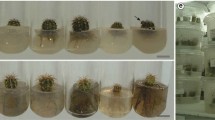Abstract
At the genebank of IPK (Leibniz Institute of Plant Genetics and Crop Plant Research) in Gatersleben, Germany, three long-term conservation methods (field genebank, in vitro slow-growth and cryopreservation) are used for mint germplasm. The plant material of the field genebank was the source to establish the slow-growth in vitro culture collection, from which the cryopreserved collection was set up, using a droplet-vitrification protocol. The genetic identity of 161 samples of three mint accessions (MEN 198, MEN 166 and MEN 186), stored for several years using those three methods, was studied using RAPD markers. Accession ‘MEN 198’ was the only one with a unique RAPD fragment pattern for all its samples, independently of the conservation procedure employed. The field collections of accessions ‘MEN 166’ and ‘MEN 186’ were made up of different genotypes. None of the genotypes detected in the plots of these accessions was represented in the in vitro and cryopreserved samples analyzed, which showed a unique genotype for each accession. From this work we conclude that, for an appropriate management of a germplasm collection of vegetatively propagated species, the determination of the genetic composition of the donor material and a periodical assessment of the preserved material should be carried out.



Similar content being viewed by others
References
Ellstrand NC, Roose ML (1987) Patterns of genotypic diversity in clonal plant species. Am J Bot 74:123–131
Engelmann F (1997) In vitro conservation methods. In: Callow JA, Ford-Lloyd B, Newbury HJ (eds) Biotechnology and plant genetic resources: conservation and use. CAB International, Wallingford, pp 119–162
Fenwick AL, Ward SM (2001) Use of random amplified polymorphic DNA markers for cultivar identification in mint. HortScience 36:761–764
Frankel OH (1970) Genetic conservation in perspective. In: Frankel OH, Bennett E (eds) Genetic resources in plants—their exploration and conservation. IBP Handbook No. 11. Blackwell Scientific Publications, Oxford, pp 469–489
Gawel NJ, Jarret RL (1991) A modified CTAB DNA extraction procedure of Musa and Ipomoea. Plant Mol Biol Rep 9:262–266
Ghani YA (2001) Introduction to field genebank. In: Saad MS, Rao VR (eds) Establishment and management of field genebank, a training manual. IPGRI-APO, Serdang, pp 59–63
Harding K (2004) Genetic integrity of cryopreserved plant cells: a review. CryoLetters 25:3–22
Hayward MD, Sackville Hamilton NR (1997) Genetic diversity-population structure and conservation. In: Callow JA, Ford-Lloyd BV, Newbury HJ (eds) Biotechnology and plant genetic resources—conservation and use. CAB International, Wallingford, pp 49–76
Holsinger KE, Gottlieb LD (1991) Conservation of rare and endangered plants: principles and prospects. In: Falk DA, Holsinger KE (eds) Genetics and conservation of rare plants. Oxford University Press, New York, pp 195–223
Jain SM, Brar DS, Ahloowalia BS (1998) Somaclonal variation in crop improvement. In: Jain SM, Brar DS, Ahloowalia BS (eds) Somaclonal variation and induced mutations in crop improvement. Kluwer, Dordrecht, pp 81–104
Keller ERJ (2006) Die Erhöhung von Effektivität und Sicherheit bei der Erhaltung permanent vegetativer Genbank-Akzessionen durch In vitro-Kultur und Kryokonservierung. Vortr Pflanzenzüchtg 70:16–26
Keller ERJ, Senula A, Leunufna S, Grübe M (2006) Slow growth storage and cryopreservation—tools to facilitate maintenance of vegetatively propagated crops in living plant collections. Int J Refrig 29:411–417
Keller ERJ, Panis B, Engelmann F (2012) In vitro storage and cryopreservation as substantial complements in concerted actions to better maintain and use crop germplasm. Acta Hortic (in press)
Li Q, Xu Z, He T (2002) Ex situ genetic conservation of endangered Vatica guanxiensis (Dipterocarpaceae) in China. Biol Conserv 106:151–156
Lushai G, Loxdale HD (2002) The biological improbability of a clone. Genet Res 79:1–9
Maaß HI, Klaas M (1995) Intraspecific differentiation of garlic (Allium sativum L.) by isozyme and RAPD markers. Theor Appl Genet 91:89–97
Marita JM, Rodríguez JM, Nienhuis JM (2000) Development of an algorithm identifying maximally diverse core collections. Genet Resour Crop Ev 47:515–526
Martin C, Gonzalez-Benito ME (2005) Survival and genetic stability of Dendranthema grandiflora Tzvelev shoot apices after cryopreservation by vitrification and encapsulation-dehydration. Cryobiology 51:281–289
Martin C, Cervera MT, Gonzalez-Benito ME (2011) Genetic stability analysis of chrysanthemum (Chrysanthemum x morifolium Ramat) after different stages of an encapsulation-dehydration cryopreservation protocol. J Plant Physiol 168:158–166
Murashige T, Skoog F (1962) A revised medium for rapid growth and bio assays with tobacco tissue cultures. Physiol Plantarum 15:473–497
Reed B (2001) Implementing cryogenic storage of clonally propagated plants. CryoLetters 22:97–104
Rohlf FJ (1992) NTSYS-PC: numerical taxonomy and multivariate analysis system. Exeter Software, New York
Sakai A, Kobayashi S, Oiyama I (1990) Cryopreservation of nucellar cells of navel orange (Citrus sinensis Osb. var. brasiliensis Tanaka) by vitrification. Plant Cell Rep 9:30–33
Sánchez C, Martinez MT, Vidal N, San-Jose MC, Valladares S, Vieitez AM (2008) Preservation of Quercus robur germplasm by cryostorage of embryogenic cultures derived from mature trees and RAPD analysis of genetic stability. CryoLetters 29:493–504
Senula A, Keller ERJ, Sanduijav T, Yohannes T (2007) Cryopreservation of cold-acclimated mint (Mentha spp.) shoot tips using a simple vitrification protocol. CryoLetters 28:1–12
Shasany AK, Darokar MP, Dhawan S, Gupta AK, Gupta S, Shukla AK, Patra NK, Khanuja SPS (2005) Use of RAPD and AFLP markers to identify inter- and intraspecific hybrids of Mentha. J Hered 96:542–549
Vining KJ, Zhang Q, Tucker AO, Smith C, Davis TM (2005) Mentha longifolia (L.) L.: a model species for mint genetic research. HortScience 40:1225–1229
Acknowledgments
This research was supported by the Spanish Government projects AGL2007-65938-C02-01 and AGL2010-21989-C02-01.
Author information
Authors and Affiliations
Corresponding author
Rights and permissions
About this article
Cite this article
Martín, C., Senula, A., González, I. et al. Genetic identity of three mint accessions stored by different conservation procedures: field collection, in vitro and cryopreservation. Genet Resour Crop Evol 60, 243–249 (2013). https://doi.org/10.1007/s10722-012-9830-x
Received:
Accepted:
Published:
Issue Date:
DOI: https://doi.org/10.1007/s10722-012-9830-x




